Литература о художнике
- Aubier D. Hans Hartung. Paris: Edition Georges Fall, 1946.
- Rousseau M., Domnick O. Hans Hartung. Stuttgart: Domnick Verlag, 1949.
- Van Gindertael R. Hans Hartung. Paris: Éditions Pierre Tisné, 1960
- Tardieu J. Hans Hartung. Paris: Éditions Fernand Hazan, 1962.
- Smücking R. Hans Hartung. Brunsweig: Galerie Schmücking, 1965
- Appolino U. Hans Hartung. Milano : Fratelli Fabbri, 1966.
- Sliblik J. Hans Hartung. Prague: Odeon, 1967.
- Hans Hartung, Autoportrait/ Monique Lefebvre, ed. Paris : Bernard Grasset, 1976
- Descargues P. Hartung. Paris : Éditions Cercle d’Art, 1977
- Daix P. Hartung. Paris: Bordas/Gervis, 1990.
- Hans Hartung/ Riccardo Passoni, ed. Torino: U. Allemandi, 2000.
- Hans Hartung. Santander: Museo de Bellas Artes, 2003
- Hans Hartung/ Maurizio Calvesi, ed. Milano: Skira, 2005.
Приложения
Избранная библиография
Монографии
- Ханс Хартунг, Автопортрет , Les press du réel,2016 г.( ISBN 978-2-84066-654-7 )
- Мадлен Руссо и Оттамар Домник, Ганс Хартунг , предисловие Джеймса Джонсона Суини, Штутгарт, Домник Верлаг, 1949.
- Джузеппе Маркиори, Ганс Хартунг , Рим, галерея II Сеньо, 1958
- Рене де Сольер, Хартунг. Живопись , Антиб, музей Антиб, замок Гримальди, 1959 год.
- Roger Van Gindertael , Hans Hartung , Paris, Éditions Pierre Tisné, 1960 (английское и немецкое издания в 1961 и 1962 годах).
- Доминик Обье , Ханс Хартунг , Париж, Le Musée de Poche , Georges Fall Edition, 1961.
- Жан Тардье , Ханс Хартунг , Париж, Издательство Фернана Хазана, 1962.
- Раймонд Байер , Беседы об абстрактном искусстве , Женева, Пьер Кайе, 1964.
- Рольф Смюкинг, Ханс Хартунг , Брунсвейг, Галерея Шмукинга, 1965 (издание завершено в 1990 году).
- Умбро Апполино, Ханс Хартунг , Милан, Fratelli Fabbri, 1966.
- Уилл Громанн, Ганс Хартунг.1922, акварель , Санкт-Галлен, Erker Verlag, 1966.
- Иржи Слиблик, Ханс Хартунг , Прага, Одеон, 1967.
- Жан Тардье, Игнорируемый мир, увиденный Гансом Хартунгом , Женева, Издательство Альберта Скиры, 1974.
- Ханс Хартунг, Автопортрет , рассказ собран Моник Лефевр, Париж, Бернар Грассе, 1976 ( ISBN 978-2246004066 ) .
- Pierre Descargues , Hartung , Paris, Éditions Cercle d’Art, 1977 (английское и немецкое издания в 1977 и 1983 годах).
- Жан Тардье, Фигуры движения: 12 рисунков Ганса Хартунга , Париж, Éditions de Grenelle, 1987.
- Пьер Дайкс, Хартунг , Париж, Борда / Жервис, 1991.
- Лидия Харамбург , Ханс Хартунг , в L’École de Paris 1945-1965, Словарь художников , Невшатель, Иды и Календы, 1993 ( ISBN ) .
- Жак Дамес, фотограф Ханса Хартунга — Легенда о работе , Брюссель, Украденное письмо, 2003 г.
- Анни Клаустрес, Ханс Хартунг. Опасности приема , Дижон, Les Presses du Réel , 2005 ( ISBN 978-284066133-7 ) .
- Коллектив, Хартунг.10 перспектив , Милан, 5 Continents Éditions, 2006.
- Давиде Рампелло, Николь Лаффонт, Хартунг. Последняя работа , Gaète, Artistic Publishing, 2009.
- Одиль Бурлюро, Ганс Хартунг. Последние годы 1980-1989 , Лондон, Галерея Тимоти Тейлора, 2011.
- Коллектив, Beau Geste, Hans Hartung, художник и легионер , Aubagnes, Gallimard / Hartung-Bergman Foundation, 2016 ( ISBN 978-2-07-017873-5 ) .
- Пьер Ват, Ханс Хартунг: картина на память , Париж, Хазан, 2019.
- Томас Кирхнер, Антье Крамер-Маллорди, Мартин Шидер (ред.), Ганс Хартунг и абстракция. «Другая реальность, но тем не менее реальность» , материалы международной конференции Hans Hartung, Deutsches Forum für Kunstgeschichte и Hartung-Bergman Foundation, Дижон, Les pressses du Réel, 2019.
-
Авторитетные записи :
- ( )
- Ресурсы изобразительного искусства :
References[]
- La mort de Hans Hartung Le peintre, pionnier puis classique de l'» abstraction «, est mort, vendredi 8 décembre, à l’âge de quatre-vingt-cinq ans, Le Monde. Lundi 11 décembre 1989, p. 1. accessed on October 8, 2006.
- Müller-Yao, Marguerite Hui: Der Einfluß der Kunst der chinesischen Kalligraphie auf die westliche informelle Malerei, Diss. Bonn, Köln 1985. ISBN 3-88375-051-4
- Müller-Yao, Marguerite: Informelle Malerei und chinesische Kalligrafie, in: Informel, Begegnung und Wandel, (hrsg von Heinz Althöfer, Schriftenreihe des Museums am Ostwall; Bd. 2), Dortmund 2002, ISBN 3-611-01062-6
- Rolf Wedewer: Die Malerei des Informel. Weltverlust und Ich-Behauptung, Deutscher Kunstverlag, München, 2007. ISBN 3-422-06560-1
Hans Hartung as icon of Informel art
Hans Hartungs’s great rise took place several years after the end of the war, when he became one of the most important representatives of Informel art almost overnight with his seemingly uncontrolled restlessness and hastily thrown down formations of line and colour. In the years that followed, there was hardly an exhibition that did not feature Hans Hartung’s work: he was represented several times at Documenta in Kassel (1955, 1959, 1964) and became a member of the renowned Académie des Beaux-Arts. From 1957 to his death in 1989, Hans Hartung received prizes and awards in great numbers, including the Venice Biennale Grand International Prize and the Grand Federal Cross of Merit with Star of the Federal Republic of Germany. In 1976, the artist published his own biography under the title ‘Autoportrait’.
Hans Hartung died in the French town of Antibes on 8 December 1989, of which he had been an honorary citizen since 1976. Even years after his death, his art continues to be the subject of various exhibitions, most recently in 2014 at the Istituto Nazionale per la Grafica in Rome. With the work of Hans Hartung, the history of European Informel art would be unthinkable.
Kunsthaus Lempertz
Выставки
- : Дрезден, Галерея Генриха Кюля, Ганс Хартунг, Gemälde, Aquarelle und Zeichnungen
- : Париж, галерея Лидии Конти, Ханс Хартунг
- : Париж, галерея Лидии Конти, рисунки Гартунг 1922-1948 гг.
- : Мюнхен, Галерея Отто Штангля, Ханс Хартунг
- : Базель, Галерея современного искусства, Хартунг
- : Париж, галерея Craven, Хартунг. Рисунки 1921-1938 гг.
- : Париж, Galerie de France, Гартунг 1922-1939 гг.
- : Бирмингем , Городской музей и художественная галерея , Ханс Хартунг
- : Париж, Национальный музей современного искусства , Ханс Хартунг
- : Хьюстон , Музей изящных искусств , Ханс Хартунг
- : Нью — Йорк, Музей искусств Метрополитен , Hans Hartung Картины 1971-1975
- : Берлин, Новая национальная галерея , Ханс Хартунг — Werke aus fünf Jahrzehnten
- : Париж, Музей современного искусства города Парижа, Хартунг. Работает с 1922 по 1939 гг.
- 1981: Мангейм , Galerie Lauter , Hans Hartung: Bilder, Gouachen und Grafiken aus den 70er Jahren
- : Кольмар, музей Унтерлинден , Ханс Хартунг. Первое реферативное исследование 1922-1938 гг.
- : Лондон, Галерея Тейт, Ханс Хартунг. Работы на бумаге 1922-1956 гг.
- : Дижон, Le Consortium , Ханс Хартунг, последние картины, 1989
- : Нагоя , Центр искусств Айти , Ханс Хартунг
- : Турин , Galleria civica d’Arte moderna e contemporanea , Ханс Хартунг
- : Кельн , Музей Людвига , Ганс Хартунг. So beschwor ich den Blitz
- : Гаага , Gemeentemuseum Den Haag , Hans Hartung. Концептуализм до буквы
- 2006: Париж, Galerie Berthet-Aittouarès — Вне полей: 1970-е, картины
- : Лейпциг , Museum der bildenden Künste , Hans Hartung Spontanes Kalkül
- : Париж, Национальная библиотека Франции , Ханс Хартунг. Печать
- : Канны, Центр искусств Мальмезон , Ханс Хартунг. Дань Даниэлю Кордье
- : Зиген , Museum für Gegenwartskunst , Hartung und die Fotografe
- : Обань , музей Иностранного легиона , Центр современного искусства, Les Pénitents noirs, Beau gesture. Художник и легионер Ганса Хартунга
- : Фонд культуры Ландерно , Элен и Эдуарда Леклерков, Хартунг и лирические художники
- : Перуджа , Национальная галерея Умбрии , Ханс Хартунг. Polittici
- : Везеле , музей Зервоса , Ханс Хартунг, годы войны
- : Бонн, Художественный музей Бонна , Ханс Хартунг — Malerei als Experiment. Верке фон 1962-1989 гг.
- : Нью-Йорк, Nahmad Contemporary , Hans Hartung
- : Лондон, Галерея Саймона Ли, Ханс Хартунг
- : Нью-Йорк, галерея Perrotin, Постоянная буря — Работы с 1922 по 1989 год.
- : Париж, Музей современного искусства Парижа, Хартунг, создание жестов
Литература о художнике
- Aubier D. Hans Hartung. Paris: Edition Georges Fall, 1946.
- Rousseau M., Domnick O. Hans Hartung. Stuttgart: Domnick Verlag, 1949.
- Van Gindertael R. Hans Hartung. Paris: Éditions Pierre Tisné, 1960
- Tardieu J. Hans Hartung. Paris: Éditions Fernand Hazan, 1962.
- Smücking R. Hans Hartung. Brunsweig: Galerie Schmücking, 1965
- Appolino U. Hans Hartung. Milano : Fratelli Fabbri, 1966.
- Sliblik J. Hans Hartung. Prague: Odeon, 1967.
- Hans Hartung, Autoportrait/ Monique Lefebvre, ed. Paris : Bernard Grasset, 1976
- Descargues P. Hartung. Paris : Éditions Cercle d’Art, 1977
- Daix P. Hartung. Paris: Bordas/Gervis, 1990.
- Hans Hartung/ Riccardo Passoni, ed. Torino: U. Allemandi, 2000.
- Hans Hartung. Santander: Museo de Bellas Artes, 2003
- Hans Hartung/ Maurizio Calvesi, ed. Milano: Skira, 2005.
Литература о художнике
- Aubier D. Hans Hartung. Paris: Edition Georges Fall, 1946.
- Rousseau M., Domnick O. Hans Hartung. Stuttgart: Domnick Verlag, 1949.
- Van Gindertael R. Hans Hartung. Paris: ?ditions Pierre Tisn?, 1960
- Tardieu J. Hans Hartung. Paris: ?ditions Fernand Hazan, 1962.
- Sm?cking R. Hans Hartung. Brunsweig: Galerie Schm?cking, 1965
- Appolino U. Hans Hartung. Milano : Fratelli Fabbri, 1966.
- Sliblik J. Hans Hartung. Prague: Odeon, 1967.
- Hans Hartung, Autoportrait/ Monique Lefebvre, ed. Paris : Bernard Grasset, 1976
- Descargues P. Hartung. Paris : ?ditions Cercle d’Art, 1977
- Daix P. Hartung. Paris: Bordas/Gervis, 1990.
- Hans Hartung/ Riccardo Passoni, ed. Torino: U. Allemandi, 2000.
- Hans Hartung. Santander: Museo de Bellas Artes, 2003
- Hans Hartung/ Maurizio Calvesi, ed. Milano: Skira, 2005.
Литература о художнике
- Aubier D. Hans Hartung. Paris: Edition Georges Fall, 1946.
- Rousseau M., Domnick O. Hans Hartung. Stuttgart: Domnick Verlag, 1949.
- Van Gindertael R. Hans Hartung. Paris: Éditions Pierre Tisné, 1960
- Tardieu J. Hans Hartung. Paris: Éditions Fernand Hazan, 1962.
- Smücking R. Hans Hartung. Brunsweig: Galerie Schmücking, 1965
- Appolino U. Hans Hartung. Milano : Fratelli Fabbri, 1966.
- Sliblik J. Hans Hartung. Prague: Odeon, 1967.
- Hans Hartung, Autoportrait/ Monique Lefebvre, ed. Paris : Bernard Grasset, 1976
- Descargues P. Hartung. Paris : Éditions Cercle d’Art, 1977
- Daix P. Hartung. Paris: Bordas/Gervis, 1990.
- Hans Hartung/ Riccardo Passoni, ed. Torino: U. Allemandi, 2000.
- Hans Hartung. Santander: Museo de Bellas Artes, 2003
- Hans Hartung/ Maurizio Calvesi, ed. Milano: Skira, 2005.
Hans Hartung
Leipzig
1904 —
Antibes
1989
«In my opinion the painting which is called abstract is none of the «Isms» of which there have been so many lately, it is neither a «style» nor an «epoch» in art history, but merely a new means of expression, a different human language — one which is more direct than that of earlier painting». (Hans Hartung) Hans Hartung was one of the few artists who spent their entire life working in an Informel manner. He began studying philosophy and art history in 1924 at the university of Leipzig, but soon changed to the Akademie der Bildenden Künste in Leipzig and then Dresden. He continued his training in 1928 with the painter Max Doerner in Munich. This period is reflected in his oeuvre in spontaneous, sketchy line compositions in which Hartung was guided by the inspiration of chance and analysed the tension between the areas of colour and the lines. After a lengthy stay on the Balearic island Menorca Hartung settled in Paris in 1932. Here he met Kandinsky, Mondrian, Miró and Calder and exhibited works at the «Salon des Surindépendants». At the beginning of the war Hartung joined the Foreign Legion and returned to Paris in 1945 with severe injuries. He became a French citizen. His work during this period is characterised by suspended areas of colour superimposed by calligraphic bunches of lines. Hans Hartung had important exhibitions in Paris, Brussels, Munich and Basle after 1949 and frequently showed works at the «documenta» in Kassel between 1955 and 1964. He was honoured with the «Prix Guggenheim» in 1956 and awarded an honorary membership of the Akademie der Künste in Berlin. He was awarded the Great International Prize for Painting at the Biennale in Venice in 1960. During the 1960s Hartung made monochrome areas of colour in which he engraved rows of parallel grooves, thus introducing not only a calligraphic but also a three-dimensional element into his work.Hans Hartung published his memoirs called «Autoportrait» in 1976. One year later he became a member of the Académie des Beaux-Arts in Paris and in 1981 was awarded the Oskar-Kokoschka-Prize of the Republic of Austria. The large number of awards Hartung received for his work prove him to be an artist of international importance. He died in 1989 as one of the most important painters of the European Informel.
Pierre SoulagesBrou de noix et encre sur papier 66 x 46,5 cm, 1956
199,800 $Details
Emil SchumacherMatora
111,000 $Details
Fritz WinterOhne Titel
12,210 $Details
Fred ThielerDarunter Rot
11,100 $Details
Fritz WinterOhne Titel
5,994 $Details
He lost his leg during the War.
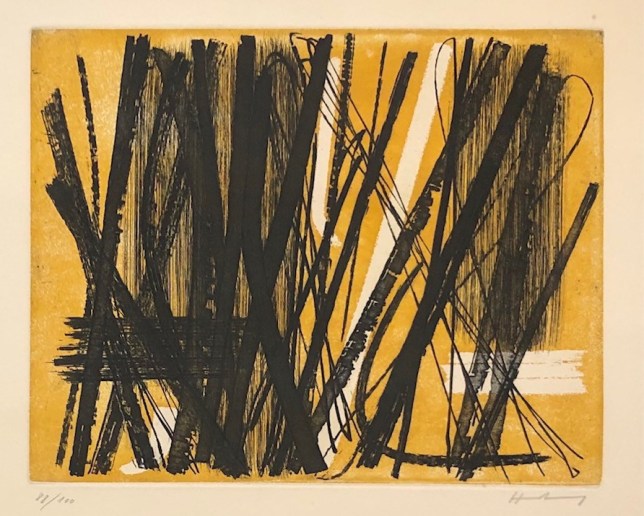 G5, Hans Hartung, 1953
G5, Hans Hartung, 1953
During the Second World War, Hartung was eager to fight against Germany, so he joined the French regular army. Due to his German nationality, he was be transferred to the Foreign Legion. In November 1944, an attack occurred in the city of Belfort which left him seriously injured. Due to this injury, his right leg had to be amputated. Hartung returned from the war traumatized, but also impatient to continue his pictorial work after 5 years of interruption. Upon his return, he was very concerned by his injuries, but also by the fact that other artists who did not go to fight, were therefore able to develop their careers and perfect their art whilst he had been fighting.
Education
Hans Hartung began his education at the schools of Dresden where the family lived during the World War I. There, Hartung received his diploma in literature.In 1924 the artist entered the Leipzig Academy of Fine Arts (Akadamie für graphische Künst und Kunstgewerbe) in Germany where he studied history of art and philosophy attending the courses by Wilhelm Pinder and Wassily Kandinsky. While in Dresden, Hartung explored the works of Georges Rouault Henri Matisse, Georges Braque and Pablo Picasso. Later, in Paris where the painter moved at the end of 1926, he got acquainted with the creations of Paul Cézanne and Van Gogh. It was at this time that Hans started to study himself the principles of harmony, its relations with mathematics, in particular, the notion of the golden section.After the two-year stint in France, the artist moved to Munich to ameliorate his artistic experience under the tutelage of a German artist Max Doerner. A year later, Hans returned to France.In 1956, Hartung became an honorary member of the Akademie der Künste in Berlin.
Жизнь
Хартунг родился в Лейпциг, Германия в артистическую семью. Он рано начал понимать Рембрандт, Немецкие художники, такие как Ловис Коринф, а Экспрессионисты Оскар Кокошка и Эмиль Нольде. В 1924 году он поступил в Лейпцигский университет, где изучал философию и историю искусства. Впоследствии он учился в Академии изящных искусств им. Дрезден, где он скопировал картины мастеров. Современные французские и испанские работы, которые он увидел в 1926 году в Internationale Kunstausstellung в Дрездене, были для него откровением. и он решил, что покинет родную страну, чтобы не поддаться провинциализму. Следовательно, после велосипедного путешествия по Италии он переехал в Париж.
В Париже Хартунг мало контактировал с другими художниками и копировал работы старых и современных мастеров. Он побывал на юге Франции, где пейзаж вдохновил его на внимательное изучение творчества Сезанн, и он проявил большой интерес к принципам гармонии и пропорции, таким как золотое сечение. В 1928 году он посетил Мюнхен где учился технике живописи с Макс Дорнер. В 1929 году женился на художнице. Анна-Ева Бергман и обосновался во французских городах Лейкат, а затем в испанский Балеарские острова, в итоге поселившись в Менорка. Впервые он выставился в 1931 году в Дрездене.
Ханс Хартунг, 1955. Фото автора Паоло Монти, 1955 (Фонд Паоло Монти, BEIC )
Смерть его отца в 1932 году разорвала последние узы Хартунга с Германией. Он был отвергнут из нацистской Германии как «дегенерат», потому что его стиль живописи был связан с Кубизм — художественное движение, несовместимое с идеалами нацистской Германии. В 1935 году, когда он пытался продать картины во время посещения Берлина, полиция пыталась его арестовать. Он смог бежать из страны с помощью своего друга. Кристиан Зервос.
После того, как он вернулся в Париж в качестве беженца, Хартунг и его жена развелись, и он впал в депрессию. Его картины становились все более абстрактными и плохо продавались. Друзья пытались помочь ему с финансовыми трудностями, и скульптор Хулио Гонсалес предложил ему использовать свою студию. В 1939 году Хартунг женился на дочери Гонсалеса. Роберта.
В декабре 1939 года он стал членом Французский Иностранный Легион. За ним внимательно следили Гестапо и арестован французской полицией на семь месяцев. После того, как они узнали, что он художник, его поместили в красную камеру, чтобы нарушить его зрение. После освобождения он вернулся в Легион, чтобы сражаться в Северная Африка, потеряв ногу в битве рядом Белфорт. Он получил французское гражданство в 1945 году и был награжден Croix de Guerre.
В 1947 году в Париже состоялась его первая персональная выставка. К концу 1950-х он добился признания своих жестов, которые были почти монохромными и характеризовались конфигурациями длинных ритмических мазков или царапин. В 1960 г. награжден Международной Гран При для рисования на Венецианская биеннале.
Свободные абстрактные картины Хартунга создали влиятельные прецеденты для многих молодых американских художников шестидесятых годов, сделав его важным предшественником американского искусства. Лирическая абстракция 1960-х и 1970-х годов. Он был показан в документальном фильме 1963 года. Парижская школа: (5 художников за работой) американского режиссера Уоррен Форма.
В 1957 году Хартунг и Анна-Ева Бергман снова поженились. Умер 7 декабря 1989 г. в г. Антиб, Франция.
Alain Resnais made a film about him.
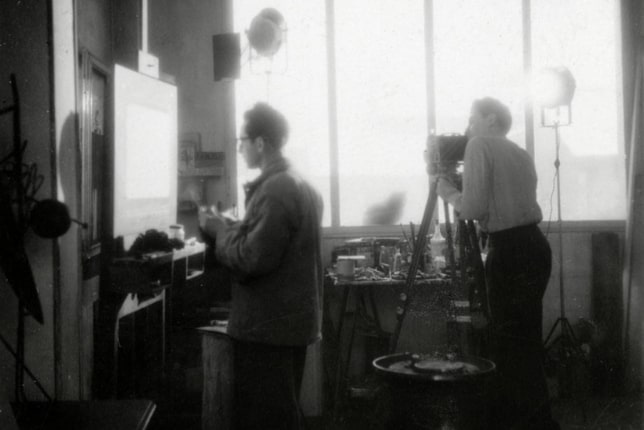 Alain Resnais in Hartung’s studio, Arcueil, 1947@ Fondation Hartung-Bergman
Alain Resnais in Hartung’s studio, Arcueil, 1947@ Fondation Hartung-Bergman
Despite the fact that he had not finished his film studies, the young Alain Resnais remained close to some of his professors at IDHEC (Institut des Hautes Études Cinématographiques), notably the art critic Madeleine Rousseau, who introduced him to Hans Hartung in 1947. Resnais thus shot a film on Hartung, 7 minutes long, in 16mm, black and white and for budget reasons, silent. The film screened in 1950 as part of the first monograph on Hartung’s work at Galerie La Hune, and depicted the artist in his Parisian studio, in the middle of his creative process.
6
14683
Stateless, foreign legionnaire and war hero
His first marriage in 1929 to the Norwegian painter Anna-Eva Berman was dissolved only a short time later at the instigation of her mother. At that time, Hans Hartung did not own a passport and as a stateless person, was unable to travel to Oslo to communicate with his wife. A stay in Paris proved formative, where, in addition to his role model Kandinsky, he made the acquaintance of Alexander Calder, Joan Miró and Piet Mondrian, and in the ensuing period, Hartung took part in several exhibitions in the Salon des Surindépendants. He joined the Foreign Legion in France in 1939 and fought in the Second World War but lost a leg in 1944 as a result of a serious wound and returned to France an invalid. There he acquired not only French citizenship in 1946 but was also inducted into the Legion of Honour. In 1952 he met his former wife Anna-Maria Bergman again, and they married a second time. This marriage held until her death in 1987.
Hans Hartung 20th century French artist who predetermined the development of European Tachism
Hans Hartung is a 20th century French artist known for his exquisite calligraphic painting. The work of Hans Hartung is notable for its duality, possessing the features of art, and a kind of alternative. The master’s paintings, executed in the manner of tachism, reflect the deep processes of the human psyche and evoke associations with the elements of nature.
Hans Hartung moved away from reality, expressing his inner state with the help of abstract spots and lines. He believed that abstraction is “a completely new means of expression, another human language, more direct.”
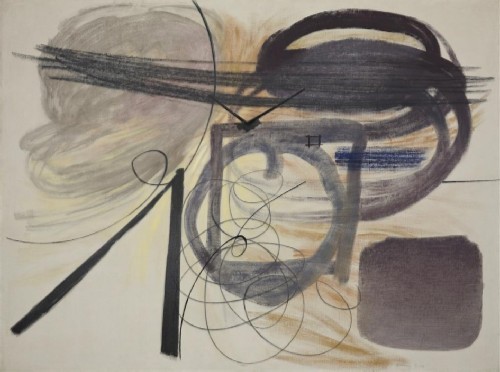 Hans Hartung. Painting T 1947-14, 1947
Hans Hartung. Painting T 1947-14, 1947
Biography
As a teenager, he was fond of photography. Later he studied in Dresden. In the summer he traveled on a bicycle across Europe, where he visited museums and exhibitions, copied the works of Rembrandt (Rembrandt Harmensz van Rijn), Germanic and Austrian Expressionists. He came to non-figurative art in 1922.
In 1925, the painter graduated from the Faculty of Philosophy and Art History at the University of Leipzig, then attended classes at the Munich Academy of Arts. Since 1926, Hartung traveled extensively around the world. Having visited Paris, he adopted the innovative techniques of the representatives of Cubism and Fauvism. And in 1935 the artist finally settled in the capital of France. By 1938, the master managed to develop his own unique style in creating an emotional effect. The center of his compositions was a bunch of lines, around which further work was built and various variations of the main tone were demonstrated.
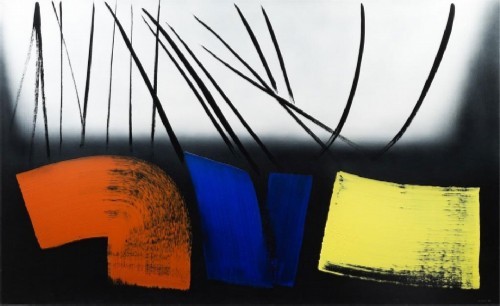 T 1973-E12», 1973
T 1973-E12», 1973
During World War II, the artist served in the Foreign Legion, took part in the hostilities in North Africa. After demobilization in 1943, he fled from occupied France to Spain. However, arrest could not be avoided, and Hans Hartung spent seven months in a French concentration camp. Then he again joined the ranks of the Foreign Legion. In 1944, the painter was seriously wounded and lost his right leg. Upon his return to Paris in 1946, he received French citizenship and was awarded government awards.
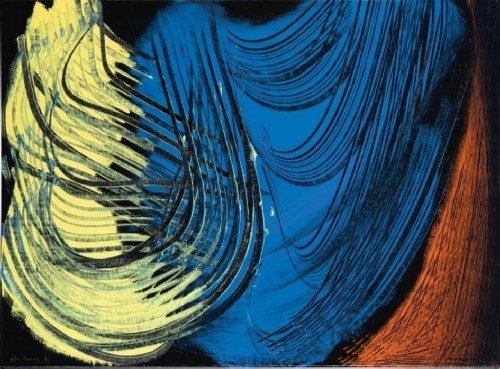 T 1971-E43», 1971
T 1971-E43», 1971
After the war, Hans Hartung received official recognition.
Large retrospective exhibitions of his works were unfolded in museums in Europe and the United States. The artist has received many prestigious awards, was a member of the Berlin Academy of Fine Arts.
The abstract artist systematically worked with black. Fast strokes in pictures begin to seem either deformed hieroglyphic writing, or pulsating on the oscilloscope screen. The works show an attempt to transfer from the world of real objects to the world of interaction of lines and color, where the true secret knowledge is located.
Hartung was in constant creative search for new methods of artistic expression. He invented gratting a method in which a drawing was scratched on a wet paint surface. Hans Hartung died on December 7, 1989. In the memory of his descendants, he remained as one of the most famous artists of the European Informer.
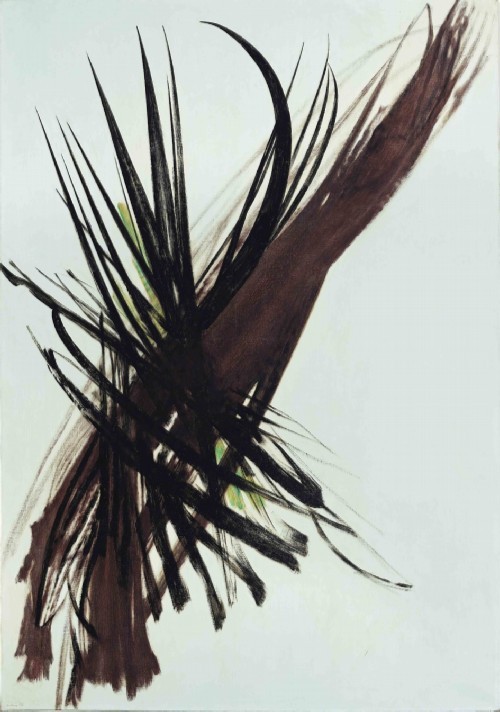 T 1955-9», 1955
T 1955-9», 1955
The most famous paintings by Hans Hartung
Hans Hartung’s paintings do not need special argumentation, they completely free the viewer’s imagination. Therefore, the author used only the year of creation and the “serial number” of the work as the title of his works.
- “T 1947-14” (1947) the geometry of a changeable internal state.
- “T 1948-3” (1948) broad, closed-off, shapeless black lines on a clear blue fill. In a sense, this is a reflection of the gloom of being against the background of the height and infinity of the sky.
- “T 1963-R50” (1963) crossing of vertical and horizontal lines with varying pressure, as a symbolic image of experiences of different strength and opposite in shades: cold blue and warm yellow.
- “T1989-L4” (1989) the motive of the space, streaked with spray flying from the invisible wind.
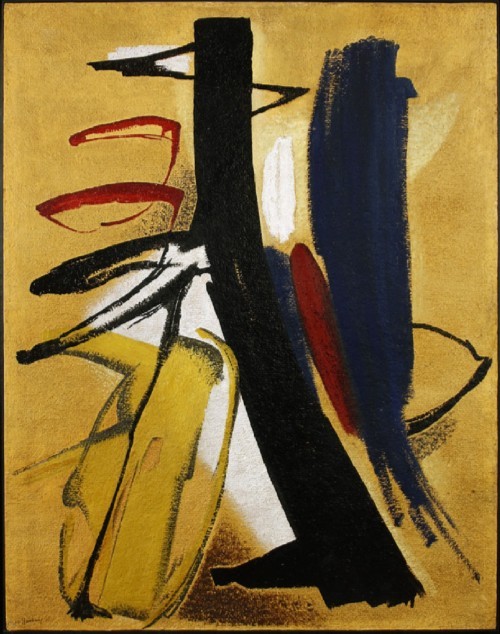 T 1938-11», 1938
T 1938-11», 1938
Литература о художнике[править | править код]
- Aubier D. Hans Hartung. Paris: Edition Georges Fall, 1946.
- Rousseau M., Domnick O. Hans Hartung. Stuttgart: Domnick Verlag, 1949.
- Van Gindertael R. Hans Hartung. Paris: Éditions Pierre Tisné, 1960
- Tardieu J. Hans Hartung. Paris: Éditions Fernand Hazan, 1962.
- Smücking R. Hans Hartung. Brunsweig: Galerie Schmücking, 1965
- Appolino U. Hans Hartung. Milano : Fratelli Fabbri, 1966.
- Sliblik J. Hans Hartung. Prague: Odeon, 1967.
- Hans Hartung, Autoportrait/ Monique Lefebvre, ed. Paris : Bernard Grasset, 1976
- Descargues P. Hartung. Paris : Éditions Cercle d’Art, 1977
- Daix P. Hartung. Paris: Bordas/Gervis, 1990.
- Hans Hartung/ Riccardo Passoni, ed. Torino: U. Allemandi, 2000.
- Hans Hartung. Santander: Museo de Bellas Artes, 2003
- Hans Hartung/ Maurizio Calvesi, ed. Milano: Skira, 2005.
Фотограф Хартунг
Ханс Хартунг с телескопом, Дрезден, 1916 год.
Хартунг очень рано интересовался фотографией. В детстве он сделал собственное устройство, установив коробку для сигар на телескопе, который служил темной комнатой. Таким образом, он фотографирует свои первые далекие виды, в том числе фотографию луны в 1916 году. Эти ранние эксперименты знаменуют начало страсти, которая продлится всю жизнь и будет развиваться параллельно с его живописью.
«У меня есть привычка фотографировать все», — признался художник в середине 1970-х. Оснащенный камерой Leica и Minox , Хартунг особенно часто фотографировал людей вокруг себя и тех, кого он знал каждый день. Он встречается. Результатом стало обильное производство портретов, в том числе Жоржа Помпиду , Марка Ротко , Марселя Брейера , Александра Колдера , Зао Ву-Ки , Генри Гельдзалера , Ганса Рихтера и т. Д. Произведенные таким образом произведения действуют, по его собственным словам, как «второе воспоминание»: «закрепленное на пленке, — утверждает он, — воспоминание восстанавливает всю свою силу, всю свою остроту, пробуждает обстоятельства. »
Для художника все предметно: помимо портретов, с 1960-х годов он делал многочисленные аэрофотоснимки во время своих воздушных путешествий, в частности облачных слоев. Абстракция никогда не заходит далеко в ее выборе съемок: эффекты тени и света, продолговатые камешки, трещины и пятна образуют репертуар узоров, которые имеют отношение к ее живописи. Выискивая малейшие визуальные странности, он без колебаний пользуется недостатками и случайностями фильма. Он также играет на выдержке, получая в 1960-х годах световые эффекты, сравнимые с эффектами его картин, сделанных с помощью спрея.
Однако было бы неправильно резюмировать его фотографическую практику как подготовительную работу к его живописным работам или даже как их дублирование. ВАвгуст 1960 г.журнал Camera в новаторском досье, посвященном этой теме, считает, что художник нашел в фотографии инструмент, позволяющий ему подтвердить существование его абстрактных интуиций в окружающем мире.
Если досье Камеры положило начало реальному распространению фотографий Хартунга, то первые выставки этой части его работ не проводились до 1970-х годов. Одна из самых ярких ретроспективов состоялась в 1982 году в Национальном музее современного искусства , курируемым Аленом Саягом
Эти исчерпывающие выставки принимают во внимание самые первые фотографии художника, подчеркивая новаторскую роль фотографии в ее поисках замечательных и абстрактных форм.
Рекомендации
- La mort de Hans Hartung Le peintre, pionnier puis classique de l ‘abstraction, est mort, vendredi 8 décembre, à l’âge de quatre-vingt-cinq ans, Le Monde. Lundi 11 декабря 1989 г., стр. 1. Доступ 8 октября 2006 г.
- Мюллер-Яо, Маргарита Хуэй: Der Einfluß der Kunst der chinesischen Kalligraphie auf die westliche informelle Malerei, Дисс. Бонн, Кёльн 1985. ISBN 3-88375-051-4
- Мюллер-Яо, Маргарита: Informelle Malerei und chinesische Kalligrafie, в: Informel, Begegnung und Wandel, (hrsg von Heinz Althöfer, Schriftenreihe des Museums am Ostwall; Bd.2), Дортмунд 2002, ISBN 3-611-01062-6
- Рольф Ведевер: Die Malerei des Informel. Weltverlust und Ich-Behauptung, Deutscher Kunstverlag, Мюнхен, 2007. ISBN 3-422-06560-1
Hans Hartung – Childhood, youth, and initial studies in Germany
Hans Hartung was born in Leipzig on 21 September 1904. He spent his childhood and teenage years in Germany, attending a humanistic grammar school in Dresden from 1915. He already discovered his interest in abstract art in these early years and practised the creation of nonrepresentational pictures. He began studying philosophy and art history in Leipzig in 1924, but a seminal encounter with the work of the Russian Expressionist Wassily Kandinsky drove him just one year later to study painting in Leipzig and Dresden. In 1928, he went to Munich and became a student of the German Impressionist Max Doerner.
He was obsessed with the golden ratio.
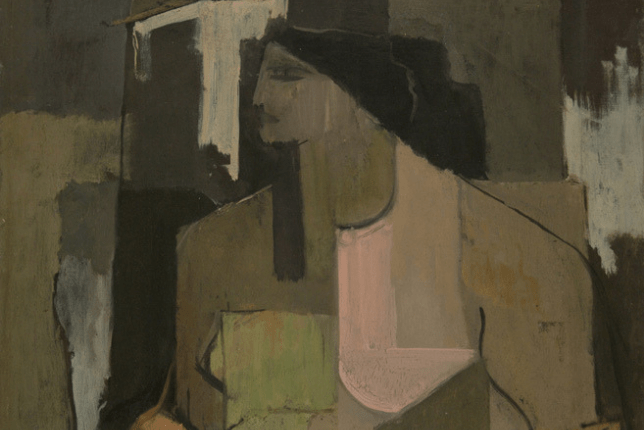 Untitled, Hans Hartung, 1927
Untitled, Hans Hartung, 1927
Towards the end of the 1920s, Hans Hartung became increasingly interested in French art, which he considered pure, healthy and refined. He said he couldn’t find these features in German art. He then became passionate about Braque and Picasso’s analytical cubism, and began to look for order in his work. Hartung saw the golden ratio as a way of organizing his composition, but also as a completely new mathematical, universal and timeless aesthetic. However in the mid-1930s, he violently rejected his mathematical research, calling it a shameful waste of time, and from then on he considered the golden ratio a sterile and limiting tool.



























